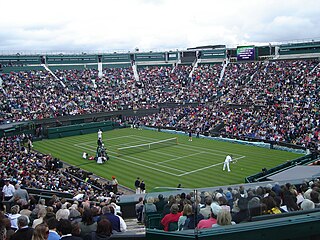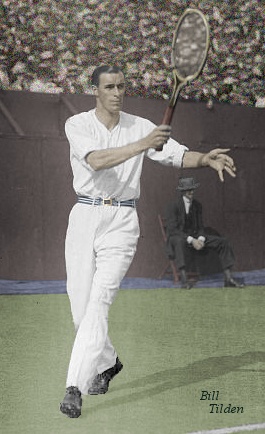
Tennis is a racket sport that is played either individually against a single opponent (singles) or between two teams of two players each (doubles). Each player uses a tennis racket that is strung with cord to strike a hollow rubber ball covered with felt over or around a net and into the opponent's court. The object of the game is to manoeuvre the ball in such a way that the opponent is not able to play a valid return. The player who is unable to return the ball validly will not gain a point, while the opposite player will.

A tennis court is the venue where the sport of tennis is played. It is a firm rectangular surface with a low net stretched across the centre. The same surface can be used to play both doubles and singles matches. A variety of surfaces can be used to create a tennis court, each with its own characteristics which affect the playing style of the game.
The Grand Slam in tennis is the achievement of winning all four major championships in one discipline in a calendar year, also referred to as the "Calendar-year Grand Slam" or "Calendar Slam". In doubles, a team may accomplish the Grand Slam playing together or a player may achieve it with different partners. Winning all four major championships consecutively but not within the same calendar year is referred to as a "non-calendar-year Grand Slam", while winning the four majors at any point during the course of a career is known as a "Career Grand Slam".

Jan Kodeš is a Czech former professional tennis player. A three-time major singles champion, Kodeš was one of the premier players in the early 1970s.

The International Tennis Federation (ITF) is the governing body of world tennis, wheelchair tennis, and beach tennis. It was founded in 1913 as the International Lawn Tennis Federation by twelve national tennis associations. As of 2016, there are 211 national and six regional associations that make up the ITF's membership.

Anthony Frederick Wilding, also known as Tony Wilding, was a New Zealand world No. 1 tennis player and soldier who was killed in action during World War I. Considered the world's first tennis superstar, Wilding was the son of wealthy English immigrants to Christchurch, Canterbury, New Zealand and enjoyed the use of private tennis courts at their home. He obtained a legal education at Trinity College, Cambridge and briefly joined his father's law firm. Wilding was a first-class cricketer and a keen motorcycle enthusiast. His tennis career started with him winning the Canterbury Championships aged 17. He developed into a leading tennis player in the world during 1909–1914 and is considered to be a former world No. 1. He won 11 Grand Slam tournament titles, six in singles and five in doubles, and is the first and to date only player from New Zealand to have won a Grand Slam singles title. In addition to Wimbledon, he also won three other ILTF World Championships : In singles, two World Hard Court Championships (WHCC) (1913–14) and one World Covered Court Championships (WCCC) (1913). With his eleven Grand Slam tournaments, two WHCC and one WCCC titles, he has a total of fourteen Major tournament titles. His sweep of the three ILTF World Championships in 1913 was accomplished on three different surfaces being the first time this has been achieved in Major tournaments.
Since 1990, the biggest events in men's tennis have been the four Grand Slam tournaments, the ATP Finals and the ATP Masters tournaments, in addition to the Grand Slam Cup between 1990–99. From 1983 to 1990, men's tennis had a very strong tradition and clear hierarchy of tournaments: the Grand Slam tournaments, including Wimbledon, the US Open, the French Open, and the Australian Open; the season-ending Masters Grand Prix; and the Davis Cup. Before 1983, however, and in particular before the start of the Open Era in 1968, the hierarchy of professional tournaments changed virtually every year. For example, in 1934, the U.S. Pro was a high-class tournament with all the best players, but just two years later, the same tournament was ordinary because only professional teachers entered the event.

The racket sport traditionally named lawn tennis, invented in Birmingham, England now commonly known simply as tennis, is the direct descendant of what is now denoted real tennis or royal tennis, which continues to be played today as a separate sport with more complex rules. Most rules of (lawn) tennis derive from this precursor and it is reasonable to see both sports as variations of the same game. Most historians believe that tennis was originated in the monastic cloisters in northern France in the 12th century, but the ball was then struck with the palm of the hand; hence, the name jeu de paume. It was not until the 16th century that rackets came into use, and the game began to be called "tennis." It was popular in England and France, and Henry VIII of England was a big fan of the game, now referred to as real tennis.

Harry Lee was a British tennis player. He was a two time Davis Cup winner (1933-1934) and a semi finalist at the 1933 French Championships. Between 1927 and 1950 Lee won 12 career singles titles.
World Hard Court Championships was an annual major tennis tournament sanctioned by the International Lawn Tennis Federation and held from 1912 to 1923. It was principally held in Paris, on clay courts of the Stade Français in the Paris suburb of Saint-Cloud, with one exception when they were held at the Royal Leopold Club in Brussels, Belgium, in 1922.

William Laurentz was a French tennis player of the early 20th century whose main achievements were winning the singles title at the World Hard Court Championships and World Covered Court Championships.

The 1972 Commercial Union Assurance Grand Prix was a professional tennis circuit held that year and organized by the International Lawn Tennis Federation (ILTF). It consisted of 33 Grand Prix tournaments in different categories including three of the four Grand Slam tournaments and was followed by a season-ending Masters tournament. The circuit ran from February through November.
100 Greatest of All Time was a sports television series of five one-hour episodes, produced and first aired by the Tennis Channel in March 2012. It presented a list of 100 tennis players to be considered the greatest of all time, both men and women. The series was hosted by Jack Nicklaus, Jerry Rice, Wayne Gretzky, Lisa Leslie and Carl Lewis. Many retired tennis luminaries provided commentary, including Rod Laver, Billie Jean King, Chris Evert, Björn Borg, John McEnroe, Martina Navratilova, Pete Sampras, and Andre Agassi.
The 2014 Wimbledon Championships was a tennis tournament played on grass courts at the All England Lawn Tennis and Croquet Club in Wimbledon, London in the United Kingdom. It was the 128th edition of the Wimbledon Championships and were held from 23 June to 6 July 2014. It was the third Grand Slam tennis event of the year and was part of the ATP World Tour, the WTA Tour, the ITF Junior Tour and the NEC Tour. The championships were organised by the All England Lawn Tennis and Croquet Club and the International Tennis Federation.
This article covers the period from 1877 to present. Before the beginning of the Open Era in April 1968, only amateurs were allowed to compete in established tennis tournaments, including the four Grand Slam tournaments. Wimbledon, the oldest of the majors, was founded in 1877, followed by the US Open in 1881, the French Open in 1891 and the Australian Open in 1905. Beginning in 1905 and continuing to the present day, all four majors have been played yearly, with the exception of during the two World Wars, 1986 for the Australian Open, and 2020 for Wimbledon. The Australian Open is the first major of the year (January), followed by the French Open (May–June), Wimbledon (June–July) and the US Open (August–September). There was no prize money and players were compensated for travel expenses only. A player who wins all four majors, in singles or as part of a doubles team, in the same calendar year is said to have achieved a "Grand Slam". If the player wins all four consecutively, but not in the same calendar year, it is called a "Non-Calendar Year Grand Slam". Winning all four at some point in a career, even if not consecutively, is referred to as a "Career Grand Slam". Winning the four majors and a gold medal in tennis at the Summer Olympics in the same calendar year has been called a "Golden Slam" since 1988. Winning all four majors plus an Olympic gold at some point in a career, even if not consecutively, is referred to as a "Career Golden Slam". Winning the year-end championship while also having won a Golden Slam is referred to as a "Super Slam". Winning all four majors, an Olympic gold, and the year-end championships at some point in a career, even if not consecutively, is referred to as a "Career Super Slam". Winning the four majors in all three disciplines a player is eligible for–singles, doubles and mixed doubles–is considered winning a "boxed set" of Grand Slam titles.
The 1912 World Hard Court Championships (WHCC) was the inaugural edition of the World Hard Court Championships tennis tournament, considered as the precursor to the French Open, and was held on the clay courts of the Stade Français at the Parc de Saint-Cloud in Paris from 1 June through 9 June 1912. This tournament was open to all international amateur tennis players and was part of a series of world championships being advanced by the International Lawn Tennis Federation (ILTF), the others being the World Grass Court Championships (Wimbledon) and the World Covered Court Championships held in a variety of countries. The WHCC was open to all nationalities unlike the French Championships which were open only to tennis players who were licensed in France.
Athar-Ali Fyzee was an Indian international tennis and table tennis player. He competed in the men's singles tennis tournament at the 1924 Summer Olympics. In a tennis career lasting 18 seasons from 1909 to 1934, he reached 21 finals and won 14 singles titles.

This was a tennis rivalry played between the French player Henri Cochet, and the American player Bill Tilden. In their respective careers the met each other on the court 35 times from 1926 until 1939 it ended with Tilden leading in head to head matches 23-12. In Major championship matches their rivalry ended with Cochet leading Tilden 4-3.










